(完整word版)大学英语四级段落信息匹配题技巧
- 格式:doc
- 大小:227.01 KB
- 文档页数:39
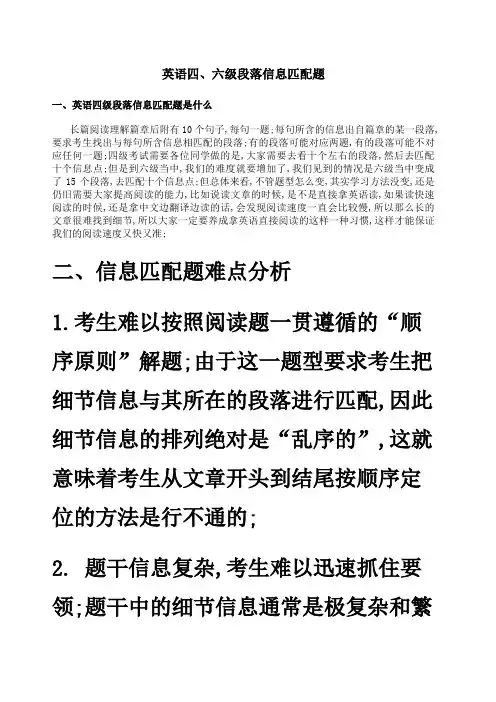
英语四、六级段落信息匹配题一、英语四级段落信息匹配题是什么长篇阅读理解篇章后附有10个句子,每句一题;每句所含的信息出自篇章的某一段落,要求考生找出与每句所含信息相匹配的段落;有的段落可能对应两题,有的段落可能不对应任何一题;四级考试需要各位同学做的是,大家需要去看十个左右的段落,然后去匹配十个信息点;但是到六级当中,我们的难度就要增加了,我们见到的情况是六级当中变成了15个段落,去匹配十个信息点;但总体来看,不管题型怎么变,其实学习方法没变,还是仍旧需要大家提高阅读的能力,比如说读文章的时候,是不是直接拿英语读,如果读快速阅读的时候,还是拿中文边翻译边读的话,会发现阅读速度一直会比较慢,所以那么长的文章很难找到细节,所以大家一定要养成拿英语直接阅读的这样一种习惯,这样才能保证我们的阅读速度又快又准;二、信息匹配题难点分析1.考生难以按照阅读题一贯遵循的“顺序原则”解题;由于这一题型要求考生把细节信息与其所在的段落进行匹配,因此细节信息的排列绝对是“乱序的”,这就意味着考生从文章开头到结尾按顺序定位的方法是行不通的;2. 题干信息复杂,考生难以迅速抓住要领;题干中的细节信息通常是极复杂和繁琐的名词短语或长难句,考生往往在寻找到合适的定位词之前,就已经被题干信息的复杂表述弄得晕头转向了;3. 考生难以寻找到合适的定位词;即使考生能够读懂题干中晦涩难懂的细节信息,但也会在寻找定位词时遇到很大障碍;因为题干提供的细节信息中往往不会出现非常明显的定位词如数字、时间、地点、人物、特殊字体和特殊符号等;即使考生能够找到一个定位词,这一定位词也通常和文章主题密切相关,会在文章中多次出现,因而也没有太大的意义;三、匹配题出题特点及应试技巧匹配类题型有很多种,常见的种类有:1人名-观点匹配;2.地名-描述匹配;3句子-句子匹配;4分类题Classification;5段落-标题匹配;6段落-细节匹配;其中前四种做题方法比较类似,而后两种相对较复杂;这里将阐述前四种题型的做题方法;1. 扭转做题思维先要扭转做题思维,不是找到句子答案所在,而是判断这句话在哪一段会出现;所以我们首要明确,考官出这个题是要考察我们什么阅读能力,我认为不是细节阅读能力,而是对文章框架思路的把握能力;2.预览题干,明确关键词该题型的解题基本思路是:先快速地将题干读一下,划出关键词;然后采用skimming和scanning的方式通读原文,匹配信息;3.快速掌握文章脉络通过阅读中心句快速掌握文章脉络;中心句一般出现在首位句,转折词如but 或者因果关系联接词如 as a result 引领的第二句,或者问句后面的答句;一般建议在找到中心句后,读一下末句,可以更精确地掌控段意;若无特别明显的中心句,首尾句的阅读也有助于理解段意;阅读过程当中,有的信息点明确可直接先去选出答案;这里我们也要明确要多看英文,掌握英文的行文思路;一般而言剑桥里的文章组织有三大类;一是按时间,如货物运输,这是最简单的; 二是按观点—原因—发展—瓶颈—措施—目标的布局来分析一件事物;三是偏科普的夹杂很多不同派别的理论,这个相对而言比较难; 4.注意字句的形式变化;在长篇阅读中寻找相关信息的难度很大程度上取决于考生对字句形式变化的辨识能力;需要注意三种变化形式:1题干只对原文中个别单词或词组进行同义改写或转述;2题干对原文中整句话进行同义改写或转述;3题干对原文中几句话或整段内容进行综合概括或推断;这就对考生的单词量、对某一单词多重释义的了解以及对句意的概括或推断能力提出了新要求; 5.注意标记;在首次阅读的过程中如果不能确定某些单句是否与该段落相匹配,最好做个记号,以便第二次阅读时更有针对性;第二次阅读的目的:一是检查已初步确定的段落与单句是否确实匹配;二是完成第一遍阅读中尚未解答的题目; 6.注意时间的合理使用,不要为确定某个细节问题而浪费大量的时间;关键词的类型1. 人名、地名和专有名词2. 一些拼写较长的词,比如:internship,competitiveness,globaliz ation,integration,sustainability,in novative,immigration等;这些词属于低频词,一般不会大篇幅地出现;利用这些词可以高效地查找匹配段落;另外,这些词有时会作为生词在文中标注出来,像internship,在原文中用斜体印刷,并以括号备注中文;我们选它做关键词,瞬间就能找到原文出处了;2. 数字,包括年代、百分比、特殊事件等;如四级样卷中的:mid-1970s, percent,20 percent,September 11等;教研君利用这些数字进行定位,测得的准确率是100%哦3. 以连字符连接的特殊词汇;如:university-based,one-child;这些词是由两个或三个单词连接的新词,一般当成形容词使用;三个单词的例子如:hard-to-grasp难以理解的;这些词也属于低频词,一般不会大篇幅出现;需要注意的是有时候我们需要将这些词拆开来定位,如one-child在原文中是没有的,原文是这样的“They often compromise by having ju st one child. ”这里的one child就不是整体作为形容词使用了;4. 研究、报告、书籍型词汇,如:report,study,books等;一般来说研究、报告等内容都是易考点,这些信息经常出现在特定的段落里,所以根据这些词汇作为关键词也很容易定位;5. 最高级,如best,worst,most等;如六级第54题,关键词之一为the best solution;然而仅凭此关键词我们可能无法迅速地找到答案,因为原文的表述是the most effective method,用的词汇是完全不一样的;这时,我们还需要增加一个关键词pension,帮助我们定位;这就提醒我们在平常的阅读中应多关注最高级出现的地方,因为它常常是考点;6. 具有特殊意义的指示性词汇;这类词汇虽然不是通常意义上的定位关键词,但其特殊含义可将考生的注意力指向原文的开头、结尾或是某个具有特殊特征的段落;这些词通常包括如下三类:①能够指示开头段的词汇如overview、introduction、initiation、main idea、definition等;②能够指示结尾段的词如overview、future、 solution、conclusion、suggestion、summary等;③能够帮助考生回原文定位的特殊词汇如rate、ratio、proportion、percentage 等词往往对应含“%”的段落;number、figure、statistical demographics等词往往对应数字集中的段落;financial、income、revenue、salary等词往往对应含诸如“$”“¥”等货币符号的段落;考生能够通过这些指示性词汇缩小回原文定位的范围,从而快速判定表1—四级样卷长篇阅读表2—六级样卷长篇阅读Passage OneUniversities Branch OutA As never before in their long history, universities have become instruments of national competition as well as instruments of peace. They are the place of the scientific discoveries that move economies forward, and the primarymeans of educating the talent required to obtain and maintain competitive advantage. But at the same time, the opening of national borders to the flow of goods, services, information and especially people has made universities a powerful force for global integration, mutual understanding and geopolitical stability.B In response to the same forces that have driven the world economy, universities have become more self-consciously global: seeking students from around the world who represent the entire range of cultures and values, sending their own students abroad to prepare them for global careers, offering courses of study that address the challenges of an interconnected world and collaborative 合作的research programs to advance science for the benefit of all humanity.C Of the forces shaping higher education none is more sweeping than the movement across borders. Over the past three decades the number of students leaving home each year to study abroad has grown at an annual rate of percent, from 800,000 in 1975 to million in 2004. Most travel from one developed nation to another, but the flow from developing to developed countries is growing rapidly. The reverse flow, from developed to developing countries, is on the rise, too. Today foreign students earn 30 percent of the doctoral degrees awarded in the United States and 38 percent of those in the United Kingdom. And the number crossing borders for undergraduate study is growing as well, to 8 percent of the undergraduates at America’s best institutions and 10 percent of all undergraduates in the . In the United States, 20 percent of the newly hiredprofessors in science and engineering are foreign-born, and in China many newly hired faculty members at the top research universities received their graduate education abroadD Universities are also encouraging students to spend some of their undergraduate years in another country. In Europe, more than 140,000 students participate in the Erasmus program each year, taking courses for credit in one of 2,200 participating institutions across the continent. And in the United States, institutions are helping place students in summer internships 实习abroad to prepare them for global careers. Yale and Harvard have led the way, offering every undergraduate at least one international study or internship opportunity—and providing the financial resources to make it possible.E Globalization is also reshaping the wayresearch is done. One new trend involves sourcing portions of a research program to another country. Yale professor and Howard Hughes Medical Institute investigator Tian Xu directs a research center focused on the genetics of human disease at Shanghai’s Fudan University, in collaboration with faculty colleagues from both schools. The Shanghai center has 95 employees and graduate students working in a 4,300-square-meter laboratory facility. Yale faculty, postdoctors and graduate students visit regularly and attend videoconference seminars with scientists from both campuses. The arrangement benefits both countries; Xu’s Yale lab is more productive, thanks to the lower costs of conducting research in China, and Chinese graduate students, postdoctors and faculty get on-the-job training from a world-class scientist and his . team.F As a result of its strength in science, the United States has consistently led the world in the commercialization of major new technologies, from the mainframe computer and the integrated circuit of the 1960s to the Internet infrastructure 基础设施and applications software of the 1990s. The link between university-based science and industrial application is often indirect but sometimes highly visible: Silicon Valley was intentionally created by Stanford University, and Route 128 outside Boston has long housed companies spun off from MIT and Harvard. Around the world, governments have encouraged copying of this model, perhaps most successfully in Cambridge, England, where Microsoft and scores of other leading software and biotechnology companies have set up shop around the university.G For all its success, the United Statesremains deeply hesitant about sustaining the research-university model. Most politicians recognize the link between investment in science and national economic strength, but support for research funding has been unsteady. The budget of the National Institutes of Health doubled between 1998 and 2003, but has risen more slowly than inflation since then. Support for the physical sciences and engineering barely kept pace with inflation during that same period. The attempt to make up lost ground is welcome, but the nation would be better served by steady, predictable increases in science funding at the rate of long-term GDP growth, which is on the order of inflation plus 3 percent per year.H American politicians have great difficulty recognizing that admitting more foreign students can greatlypromote the national interest by increasing international understanding. Adjusted for inflation, public funding for international exchanges and foreign-language study is well below the levels of 40 years ago. In the wake of September 11, changes in the visa process caused a dramatic decline in the number of foreign students seeking admission to . universities, and a corresponding surge in enrollments in Australia, Singapore and the . Objections from American university and business leaders led to improvements in the process and a reversal of the decline, but the United States is still seen by many as unwelcoming to international students.I Most Americans recognize that universities contribute to the nation’s well-being through their scientific research, but many fear that foreign students threaten Americancompetitiveness by taking their knowledge and skills back home. They fail to grasp that welcoming foreign students to the United States has two important positive effects: first, the very best of them stay in the States and—like immigrants throughout history—strengthen the nation; and second, foreign students who study in the United States become ambassadors for many of its most cherished 珍视values when they return home. Or at least they understand them better. In America as elsewhere, few instruments of foreign policy are as effective in promoting peace and stability as welcoming international university students.1. American universities prepare their undergraduates for global careers by giving them chances for international study or internship.2. Since the mid-1970s, the enrollment ofoverseas students has increased at an annual rate of percent.3. The enrollment of international students will have a positive impact on America rather than threaten its competitiveness.4. The way research is carried out in universities has changed as a result of globalization.5. Of the newly hired professors in science and engineering in the United States, twenty percent come from foreign countries.6. The number of foreign students applying to . universities decreased sharply after September 11 due to changes in the visa process.7. The . federal funding for research has been unsteady for years.8. Around the world, governments encourage the model of linking university-based science and industrialapplication.9. Present-day universities have becomea powerful force for global integration.10. When foreign students leave America, they will bring American values back to their home countries.Passage TwoInto the unknownA Until the early 1900s nobody thought much about the whole populations getting older. UN had the foresight to convene a “world assembly on ageing” back in 1982, but that came and went. By 1994 the World Bank had noticed that something big was happening. In a report entitled “Averting the Old Age Crisis”, itargued that pension arrangements in most countries were unsustainable.B For the next ten years a succession of books, mainly by Americans, surrounded by the alarm. They had titles like Young vs. Old, Gray Dawn and The Coming Generational Storm, and their message was blunt: health-care systems were heading for the rocks, pensioners were taking young people to the cleaners, and soon there would be intergenerational warfare.C Since then the debate has become less emotional, not least because alot more is known about the subject. Books, conferences and research papers have multiplied. International organizations such as the OECD and the EU issue regular reports. Population ageing is on every agenda, from G8 economic conferences to NATO summits. The World Economic Forum plans to consider the future of pensions and health care at its prestigious Davos conference early next year. The media, including the newspaper, are giving the subject extensive coverage.D Whether all that attention hastranslated into sufficient action is another question. Governments in rich countries now accept that their pension and health-care promises will soon become unaffordable, and many of them have embarked on reforms, but so far only timidly. That is not surprising: politicians with an eye on the next election will hardly rush to introduce unpopular measures that may not bear fruit for years, perhaps decades.E The outline of the changes needed is clear. To avoid fiscal 财政的meltdown, public pensions andhealth-care provision will have to be reined back severely and taxes may have to go up. By far the most effective method to restrain pension spending is to give people the opportunity to work longer, because it increases tax revenues and reduces spending on pensions at the same time. It may even keep them alive longer. John Rother, the AARP’s head of policy and strategy, points to studies showing that other things being equal, people who remain at work have lower death rates than their retired peers.F Younger people today mostly accept that they will have to work for longer and that their pensions will be less generous. Employers still need to be persuaded that older workers are worth holding on to. That may be because they have had plenty of younger ones to choose from, partly thanks to the post-war baby-boom and partly because over the past few decades many more women have entered the labor force, increasing employers’ choice. But the reservoir of women able and willing to take up paid work is running low, and thebaby-boomers are going grey.G In many countries immigrants have been filling such gaps in the labor force as have already emerged and remember that the real shortage is still around ten years off. Immigration in the developed world is the highest it has ever been, and it is making a useful difference. In still-fertile America it currently accounts for about 40% of total population growth, and in fast-ageing Western Europe for about 90%.H On the face of it, it seems the perfect solution. Many developingcountries have lots of young people in the need of jobs, many rich countries need helping hands that will boost tax revenues and keep up economic growth. But over the next few decades labor forces in rich countries are set to shrink so much that inflows of immigrants would have to increase enormously to compensate: to at least twice their current size in western Europe’s most youthful countries, and three times in the older ones. Japan would need a large multiple of the few immigrants it has at present. Public opinion polls show that peoplein most rich countries already think that immigration is too high. Further big increases would be politically unfeasible.I To tackle the problem of ageing populations at its ro ot, “old” countries would have to rejuvenate 使年轻themselves by having more of their own children. A number of them have tried, some more successfully than others. But it is not a simple matter of offering financial incentives or providing more child care. Modern urban life in rich countries is not well adapted to largefamilies. Women find it hard to combine family and career. They often compromise by having just one child. J And if fertility in ageing countries does not pick up It will not be the end of the world, at least not for quite a while yet, but the world will become a different place. Older societies may be less innovative and more strongly disinclined to take risks than younger ones. By 2025 at the latest, about half the voters in America and most of those in western European countries will be over 50—and older people turn out to votein much greater numbers than younger ones. Academic studies have found no evidence so far that older voters have used their power at the ballot box to push for policies that specifically benefit them, though if in future there are many more of them they might start doing so.K Nor is there any sign of the intergenerational warfare predicted in the 1990s. After all, older people themselves mostly have families. In a recent study of parents and grown-up children in 11 European countries, Karsten Hank of Mannheim Universityfound that 85% of them lived within 25km of each other and the majority of them were in touch at least once a week.L Even so, the shift in the centre of gravity to older age groups is bound to have a profound effect on societies, not just economically and politically but in all sorts of other ways too. Richard Jackson and Neil Howe of America’s CSIS, in a thoughtful book called The Graying of the Great Powers, argue that, among other things, the ageing of the developed countries will have a number of serious securityimplications.M For example, the shortage of young adults is likely to make countries more reluctant to commit the few they have to military service. In the decades to 2050, America will find itself playing an ever-increasing role in the developed world’s defense effort. Because America’s population will still be growing when that of most other developed countries is shrinking, America will be the only developed country that still matters geopolitically 地缘政治上.N There is little that can be done to stop population ageing, so the world will have to live with it. But some of the consequences can be alleviated. Many experts now believe that given the right policies, the effects, though grave, need not be catastrophic. Most countries have recognized the need to do something and beginning to act.O But even then there is no guarantee that their efforts will work. What is happening now is historically unprecedented. The director of Economics and Demography of Ageing atthe University of California, Berkeley, puts it briefly and clearly: “We don’t really know what population ageing will be like, because nobody has done it yet.” 1. Employers should realize it is important to keep older workers in the workforce.2. A recent study found that most old people in some European countries had regular weekly contact with their adult children.3. Few governments in rich countries have launched bold reforms to tackle the problem of population ageing.4. In a report published some 20 years ago, the sustainability of old-age pension systems in most countries was called into doubt.5. Countries that have a shortage of young adults will be less willing to send them to war.families are more common in ageing societies due to the stress of urban life and the difficulties of balancing families and cancer.7. A series of books, mostly authored by Americans, warned of conflicts between the older and younger generations.pared with younger ones, older societies tend to be less innovative and take fewer risks.9. The best solution to the pension crisis is to postpone the retirement age.10. Immigration as a means to boost the shrinking labour force may meet with resistance in some rich countries.。
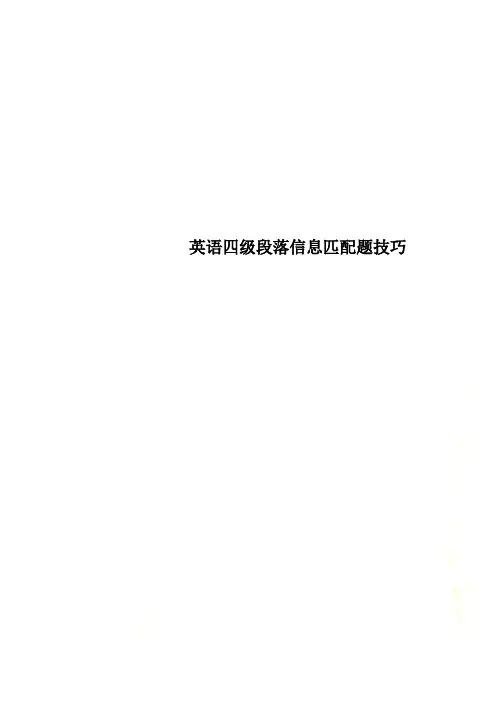
英语四级段落信息匹配题技巧英语四级段落信息匹配题一、英语四级段落信息匹配题是什么?原快速阅读理解调整为长篇阅读理解,篇章长度和难度不变。
篇章后附有10个句子,每句一题。
每句所含的信息出自篇章的某一段落,要求考生找出与每句所含信息相匹配的段落。
有的段落可能对应两题,有的段落可能不对应任何一题。
四级考试需要各位同学做的是,大家需要去看十个左右的段落,然后去匹配十个信息点。
但是到六级当中,我们的难度就要增加了,我们见到的情况是六级当中变成了15个段落,去匹配十个信息点。
但总体来看,不管题型怎么变,其实学习方法没变,还是仍旧需要大家提高阅读的能力,比如说读文章的时候,是不是直接拿英语读,如果读快速阅读的时候,还是拿中文边翻译边读的话,会发现阅读速度一直会比较慢,所以那么长的文章很难找到细节,所以大家一定要养成拿英语直接阅读的这样一种习惯,这样才能保证我们的阅读真正速度又快又准。
二、样题:Section BDirections: In this section, you are going to read a passage with ten statements attached to it. Each statement contains information given in one of the paragraphs. Identify the paragraph from which the information is derived. You may choose a paragraph more than once. Each paragraph is marked with a letter. Answer the questions by marking the corresponding letter on AnswerSheet 2.Universities Branch OutA) As never before in their long history, universities have become instruments of national competition as well as instruments of peace. They are the place of the scientific discoveries that move economies forward, and the primary means of educating the talent required to obtain and maintain competitive advantage. But at the same time, the opening of national borders to the flow of goods, services, information and especially people has made universities a powerful force for global integration, mutual understanding and geopolitical stability.B) In response to the same forces that have driven the world economy, universities have become more self-consciously global: seeking students from around the world who represent the entire range of cultures and values, sending their own students abroad to prepare them for global careers, offering courses of study that address the challenges of an interconnected world and collaborative (合作的) research programs to advance science for the benefit of all humanity.C) Of the forces shaping higher education none is more sweeping than the movement across borders. Over the past three decades the number of students leaving home each year to study abroad has grown at an annual rate of 3.9 percent, from 800,000 in 1975 to 2.5 million in 2004. Most travel from one developed nation to another, but the flow from developing to developed countries is growing rapidly. The reverse flow, from developed to developing countries, is on the rise, too. Today foreign students earn 30 percent of the doctoral degrees awarded in the United States and 38 percent of those in the United Kingdom. And the number crossing borders for undergraduate study is growing as well, to 8 percent of the under graduates at America’s best institutions and 10 percent of all undergraduates in the U.K. In the United States, 20 percent of the newly hired professors in science and engineering are foreign-born, and in China many newly hired faculty members at the top research universities received their graduate education abroad.D) Universities are also encouraging students to spend some of their undergraduate years in another country. In Europe, more than 140,000 students participate in the Erasmus program each year, taking courses for credit in one of 2,200 participating institutions across the continent. And in the United States, institutions are helping place students in summer internships (实习) abroad to prepare them for global careers. Yale and Harvard have led the way, offering every undergraduate at least one international study or internship opportunity—and providing the financial resources to make it possible.E) Globalization is also reshaping the way research is done. One new trend involves sourcing portions of a research program to another country. Yale professor and Howard Hughes Medical Institute investigator Tian Xu directs a research center focused on the genetics of human disease at Shanghai’s Fudan University, in collaboration with faculty colleagues from both schools. The Shanghai center has 95 employees and graduate students working in a4,300-square-meter laboratory facility. Yale faculty postdoctors and graduate students visit regularly and attend videoconference seminars with scientists from bo th campuses. The arrangement benefits both countries; Xu’s Yale lab is more productive, thanks to the lower costs of conducting research in China, and Chinese graduate students, postdoctors and faculty get on-the-job training from a world-class scientist and his U.S. team.F) As a result of its strength in science, the United States has consistently led the world in the commercialization of major new technologies, from the mainframe computer and the integrated circuit of the 1960s to the Internet infrastructure (基础设施) and applications software of the 1990s. The link between university-based science and industrial application is often indirect but sometimes highly visible: Silicon Valley was intentionally created by Stanford University, and Route 128 outside Boston has long housed companies spun off from MIT and Harvard. Around the world, governments have encouraged copying of this model, perhaps most successfully in Cambridge, England, where Microsoft and scores of other leading software and biotechnology companies have set up shop around the university.G) For all its success, the United States remains deeply hesitant about sustaining the research-university model. Most politicians recognize the link between investment in science and national economic strength, but support for research funding has been unsteady. The budget of the National Institutes of Health doubled between 1998 and 2003, but has risen more slowly than inflation since then. Support for the physical sciences and engineering barely kept pace with inflation during that same period. The attempt to make up lost ground is welcome, but the nation would be better served by steady, predictable increases in science funding at the rate of long-term GDP growth, which is on the order of inflation plus 3 percent per year.H) American politicians have great difficulty recognizing that admitting more foreign students can greatly promote the national interest by increasing international understanding. Adjusted for inflation, public funding for international exchanges and foreign-language study is well below the levels of 40 years ago. In the wake of September 11, changes in the visa process caused a dramatic decline in the number of foreign students seeking admission to U.S. universities, and a corresponding surge in enrollments in Australia, Singapore and the U.K. Objections from American university and business leaders led to improvements in the process and a reversal of the decline, but the United States is still seen by many as unwelcoming to international students.I) Most Americans recognize that universities contribute to the nation’s well-being through their scientific research, but many fear that foreign students threaten American competitiveness by taking their knowledge and skills back home. They fail to grasp that welcoming foreign students to the United States has two important positive effects: first, the very best of them stay in the States and—like immigrants throughout history—strengthen the nation; and second, foreign students who study in the United States become ambassadors for many ofits most cherished (珍视) values when they return home. Or at least they understand them better. In America as elsewhere, few instruments of foreign policy are as effective in promoting peace and stability as welcoming international university students.注意:此部分试题请在答题卡 2 上作答。
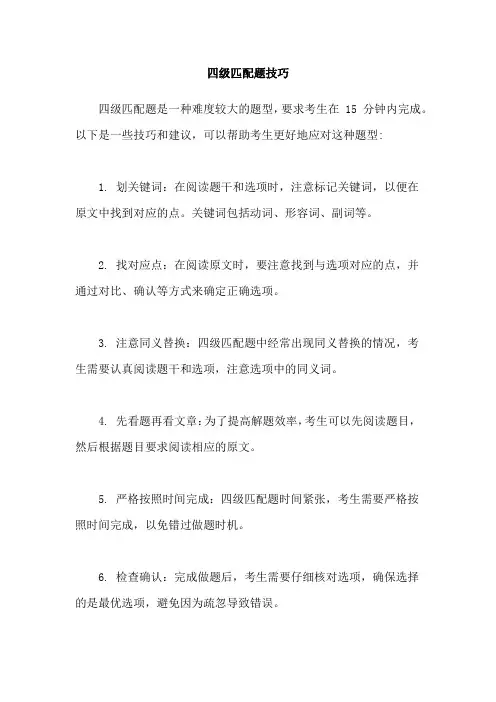
四级匹配题技巧
四级匹配题是一种难度较大的题型,要求考生在 15 分钟内完成。
以下是一些技巧和建议,可以帮助考生更好地应对这种题型:
1. 划关键词:在阅读题干和选项时,注意标记关键词,以便在
原文中找到对应的点。
关键词包括动词、形容词、副词等。
2. 找对应点:在阅读原文时,要注意找到与选项对应的点,并
通过对比、确认等方式来确定正确选项。
3. 注意同义替换:四级匹配题中经常出现同义替换的情况,考
生需要认真阅读题干和选项,注意选项中的同义词。
4. 先看题再看文章:为了提高解题效率,考生可以先阅读题目,然后根据题目要求阅读相应的原文。
5. 严格按照时间完成:四级匹配题时间紧张,考生需要严格按
照时间完成,以免错过做题时机。
6. 检查确认:完成做题后,考生需要仔细核对选项,确保选择
的是最优选项,避免因为疏忽导致错误。
以上是一些四级匹配题的技巧和建议,考生需要在实际考试中加以运用,提高解题效率和正确率。
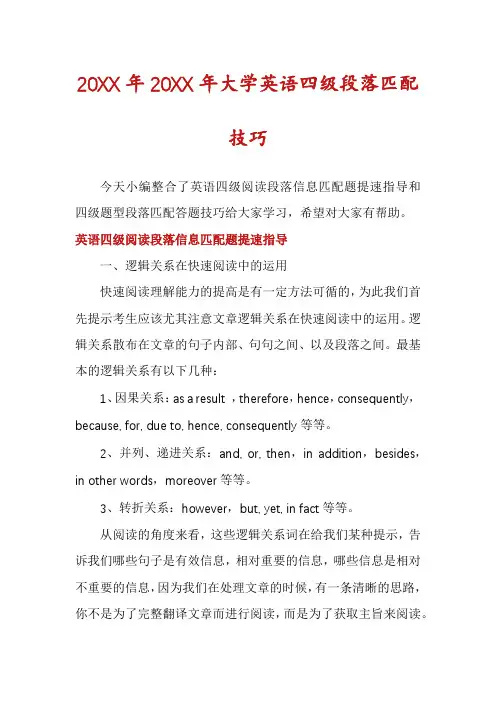
20XX年20XX年大学英语四级段落匹配技巧今天小编整合了英语四级阅读段落信息匹配题提速指导和四级题型段落匹配答题技巧给大家学习,希望对大家有帮助。
英语四级阅读段落信息匹配题提速指导一、逻辑关系在快速阅读中的运用快速阅读理解能力的提高是有一定方法可循的,为此我们首先提示考生应该尤其注意文章逻辑关系在快速阅读中的运用。
逻辑关系散布在文章的句子内部、句句之间、以及段落之间。
最基本的逻辑关系有以下几种:1、因果关系:as a result ,therefore,hence,consequently,because, for, due to, hence, consequently等等。
2、并列、递进关系:and, or, then,in addition,besides,in other words,moreover等等。
3、转折关系:however,but, yet, in fact等等。
从阅读的角度来看,这些逻辑关系词在给我们某种提示,告诉我们哪些句子是有效信息,相对重要的信息,哪些信息是相对不重要的信息,因为我们在处理文章的时候,有一条清晰的思路,你不是为了完整翻译文章而进行阅读,而是为了获取主旨来阅读。
二、标点符号在快速阅读中的运用可以运用标点符号(破折号、小括号、冒号)了解不认识的词汇或句子的含义。
因为这些标点符号的出现就是为了更进一步地其前的信息。
但同时,由于快速阅读用词相对比较简单,很容易理解和把握标点前的被解释信息,所以,可以将这些标点符号后面的信息删除,从而更加快速地把握文章的主旨。
三、特殊信息点在快速阅读中的运用所谓“特殊信息点”是指那些很容易在文章中识别的词汇,诸如时间、数字、大写字母等形式的语言点。
这些形式的表达一方面很容易识别出来,另一方面,这些信息点的表现的一般都是文章的琐碎信息,对于主旨的理解和把握而言,不过是更进一步论证而已。
因此,可以忽略这些信息的阅读。
如果后面测试的题点中确实涉及到了,再回来细读也无妨,毕竟它们的表现形式非常利于查找和定位判断。
![[实用参考]大学英语四级段落信息匹配题技巧](https://uimg.taocdn.com/8649f344561252d380eb6ecb.webp)
英语四、六级段落信息匹配题一、英语四级段落信息匹配题是什么?长篇阅读理解篇章后附有10个句子,每句一题。
每句所含的信息出自篇章的某一段落,要求考生找出与每句所含信息相匹配的段落。
有的段落可能对应两题,有的段落可能不对应任何一题。
四级考试需要各位同学做的是,大家需要去看十个左右的段落,然后去匹配十个信息点。
但是到六级当中,我们的难度就要增加了,我们见到的情况是六级当中变成了15个段落,去匹配十个信息点。
但总体来看,不管题型怎么变,其实学习方法没变,还是仍旧需要大家提高阅读的能力,比如说读文章的时候,是不是直接拿英语读,如果读快速阅读的时候,还是拿中文边翻译边读的话,会发现阅读速度一直会比较慢,所以那么长的文章很难找到细节,所以大家一定要养成拿英语直接阅读的这样一种习惯,这样才能保证我们的阅读速度又快又准。
二、信息匹配题难点分析1.考生难以按照阅读题一贯遵循的“顺序原则”解题。
由于这一题型要求考生把细节信息与其所在的段落进行匹配,因此细节信息的排列绝对是“乱序的”,这就意味着考生从文章开头到结尾按顺序定位的方法是行不通的。
2.题干信息复杂,考生难以迅速抓住要领。
题干中的细节信息通常是极复杂和繁琐的名词短语或长难句,考生往往在寻找到合适的定位词之前,就已经被题干信息的复杂表述弄得晕头转向了。
3.考生难以寻找到合适的定位词。
即使考生能够读懂题干中晦涩难懂的细节信息,但也会在寻找定位词时遇到很大障碍。
因为题干提供的细节信息中往往不会出现非常明显的定位词(如数字、时间、地点、人物、特殊字体和特殊符号等)。
即使考生能够找到一个定位词,这一定位词也通常和文章主题密切相关,会在文章中多次出现,因而也没有太大的意义。
三、匹配题出题特点及应试技巧匹配类题型有很多种,常见的种类有:1)人名-观点匹配;2).地名-描述匹配;3)句子-句子匹配;4)分类题(Classification);5)段落-标题匹配;6段落-细节匹配。
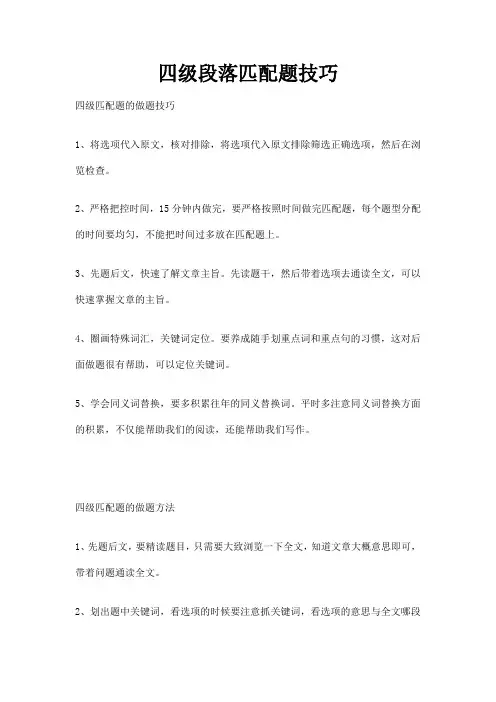
四级段落匹配题技巧
四级匹配题的做题技巧
1、将选项代入原文,核对排除,将选项代入原文排除筛选正确选项,然后在浏览检查。
2、严格把控时间,15分钟内做完,要严格按照时间做完匹配题,每个题型分配的时间要均匀,不能把时间过多放在匹配题上。
3、先题后文,快速了解文章主旨。
先读题干,然后带着选项去通读全文,可以快速掌握文章的主旨。
4、圈画特殊词汇,关键词定位。
要养成随手划重点词和重点句的习惯,这对后面做题很有帮助,可以定位关键词。
5、学会同义词替换,要多积累往年的同义替换词。
平时多注意同义词替换方面的积累,不仅能帮助我们的阅读,还能帮助我们写作。
四级匹配题的做题方法
1、先题后文,要精读题目,只需要大致浏览一下全文,知道文章大概意思即可,带着问题通读全文。
2、划出题中关键词,看选项的时候要注意抓关键词,看选项的意思与全文哪段
落意思比较接近,找关键词一定要用笔画出来。
3、把匹配题文章大致阅读一遍,通过大致浏览全文来结合选项再来看题,注意与前后文的联系是否一致,认真比对自己所选的选项和后面题中的关键词,看前后是否相同。
4、有针对性地阅读一遍,最后再有重点地带着问题去找答案。
注意事项
1、做这道题不需要一五一十全部读完原文后再选选项,只需要匹配关键词句就可以了;
2、在匹配的过程中,可能会出现两题选同一段落;
3、信息匹配题不遵循顺序原则;
4、做题限时在10分钟内解决,最长别超过15分钟
5、任何题型想拿高分,单词一定是基础!。
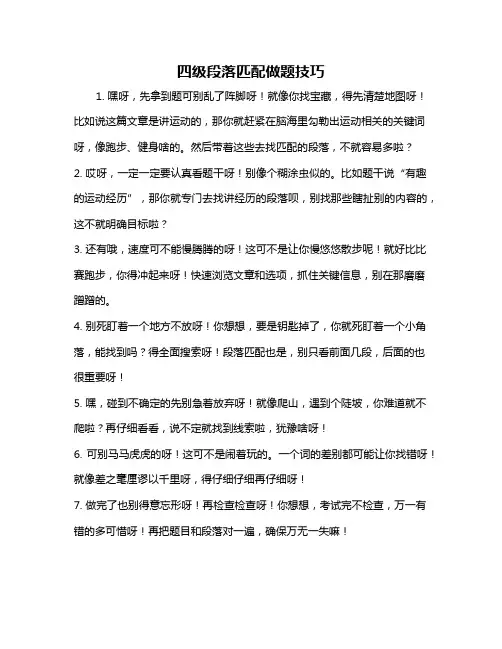
四级段落匹配做题技巧
1. 嘿呀,先拿到题可别乱了阵脚呀!就像你找宝藏,得先清楚地图呀!比如说这篇文章是讲运动的,那你就赶紧在脑海里勾勒出运动相关的关键词呀,像跑步、健身啥的。
然后带着这些去找匹配的段落,不就容易多啦?
2. 哎呀,一定一定要认真看题干呀!别像个糊涂虫似的。
比如题干说“有趣的运动经历”,那你就专门去找讲经历的段落呗,别找那些瞎扯别的内容的,这不就明确目标啦?
3. 还有哦,速度可不能慢腾腾的呀!这可不是让你慢悠悠散步呢!就好比比赛跑步,你得冲起来呀!快速浏览文章和选项,抓住关键信息,别在那磨磨蹭蹭的。
4. 别死盯着一个地方不放呀!你想想,要是钥匙掉了,你就死盯着一个小角落,能找到吗?得全面搜索呀!段落匹配也是,别只看前面几段,后面的也很重要呀!
5. 嘿,碰到不确定的先别急着放弃呀!就像爬山,遇到个陡坡,你难道就不爬啦?再仔细看看,说不定就找到线索啦,犹豫啥呀!
6. 可别马马虎虎的呀!这可不是闹着玩的。
一个词的差别都可能让你找错呀!就像差之毫厘谬以千里呀,得仔细仔细再仔细呀!
7. 做完了也别得意忘形呀!再检查检查呀!你想想,考试完不检查,万一有错的多可惜呀!再把题目和段落对一遍,确保万无一失嘛!
我的观点结论就是:只要掌握这些技巧,四级段落匹配就没那么难啦,大家加油呀!。
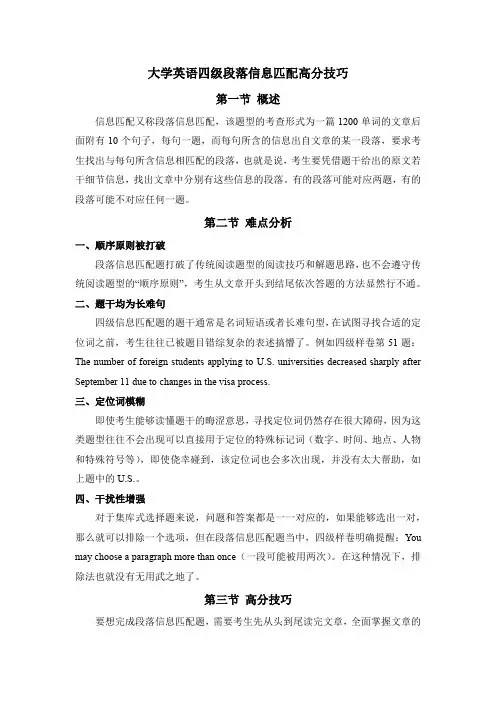
大学英语四级段落信息匹配高分技巧第一节概述信息匹配又称段落信息匹配,该题型的考查形式为一篇1200单词的文章后面附有10个句子,每句一题,而每句所含的信息出自文章的某一段落,要求考生找出与每句所含信息相匹配的段落,也就是说,考生要凭借题干给出的原文若干细节信息,找出文章中分别有这些信息的段落。
有的段落可能对应两题,有的段落可能不对应任何一题。
第二节难点分析一、顺序原则被打破段落信息匹配题打破了传统阅读题型的阅读技巧和解题思路,也不会遵守传统阅读题型的“顺序原则”,考生从文章开头到结尾依次答题的方法显然行不通。
二、题干均为长难句四级信息匹配题的题干通常是名词短语或者长难句型,在试图寻找合适的定位词之前,考生往往已被题目错综复杂的表述搞懵了。
例如四级样卷第51题:The number of foreign students applying to U.S. universities decreased sharply after September 11 due to changes in the visa process.三、定位词模糊即使考生能够读懂题干的晦涩意思,寻找定位词仍然存在很大障碍,因为这类题型往往不会出现可以直接用于定位的特殊标记词(数字、时间、地点、人物和特殊符号等),即使侥幸碰到,该定位词也会多次出现,并没有太大帮助,如上题中的U.S.。
四、干扰性增强对于集库式选择题来说,问题和答案都是一一对应的,如果能够选出一对,那么就可以排除一个选项,但在段落信息匹配题当中,四级样卷明确提醒:You may choose a paragraph more than once(一段可能被用两次)。
在这种情况下,排除法也就没有无用武之地了。
第三节高分技巧要想完成段落信息匹配题,需要考生先从头到尾读完文章,全面掌握文章的结构和细节信息之后,再进行解题,但这种方法对于阅读水平和单词量都有限的四级考生来说有些难度。
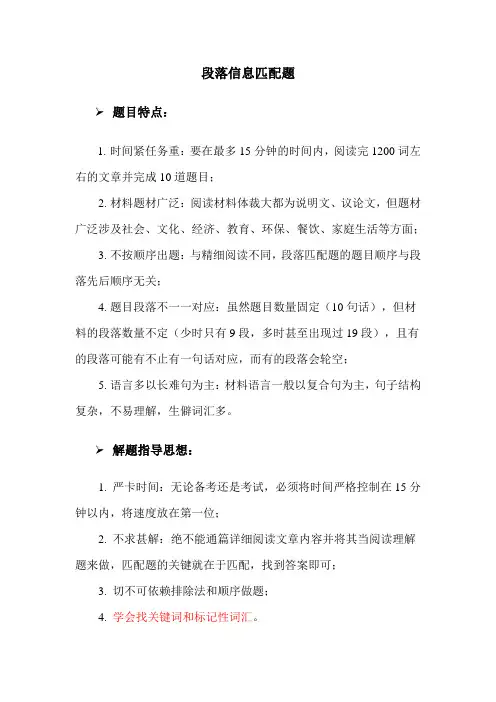
段落信息匹配题题目特点:1.时间紧任务重:要在最多15分钟的时间内,阅读完1200词左右的文章并完成10道题目;2.材料题材广泛:阅读材料体裁大都为说明文、议论文,但题材广泛涉及社会、文化、经济、教育、环保、餐饮、家庭生活等方面;3.不按顺序出题:与精细阅读不同,段落匹配题的题目顺序与段落先后顺序无关;4.题目段落不一一对应:虽然题目数量固定(10句话),但材料的段落数量不定(少时只有9段,多时甚至出现过19段),且有的段落可能有不止有一句话对应,而有的段落会轮空;5.语言多以长难句为主:材料语言一般以复合句为主,句子结构复杂,不易理解,生僻词汇多。
解题指导思想:1.严卡时间:无论备考还是考试,必须将时间严格控制在15分钟以内,将速度放在第一位;2.不求甚解:绝不能通篇详细阅读文章内容并将其当阅读理解题来做,匹配题的关键就在于匹配,找到答案即可;3.切不可依赖排除法和顺序做题;4.学会找关键词和标记性词汇。
考前准备:1.过级备考神技——卡时间:模块化做题(没有大块时间把整套练习题做完?把散碎的时间利用起来,将套题中的模块分词做完,严格要求自己,时间到就停笔);2.训练快速阅读技巧——scan:备考阅读练习时不再要求自己一目一词,训练自己囫囵吞枣的能力,一目一句一行,快速定位某个词组;3.加大同义词组的积累:从套题做起,将套题中出现的生词积累在一个词汇本上,并利用词典,词汇软件将其同义词也罗列其中,共同记忆;4.适当学习英语句法知识:备考时留意分析题目中句子的句架结构,锻炼自己可以根据句架结构辨认出句子的主、谓和宾。
5.广泛阅读:订阅China Daily手机报,增加自己阅读量,扩充自己的词汇量。
考中技巧:一、应试技巧1.段落细节信息配对题的陈述虽然都是文章细节信息,但是表述基本都是围绕文章标题或者每一段落的主题进行描述的,通过快速阅读题干部分表述,可以迅速了解文章主旨大意。
如2015年6月卷一46. Some people propose laws be made to stop McDonald’s from attaching toys to its food specials for children.47. Fast-food firms may not be able to cope with pressures from food regulation in the near future.48. Burger King will start to sell Seattle’s Best coffee to increase sales.49. Some fast-food firms provide healthy food to give the impression they are helping to tackle the obesity problem.通过这四个题干中的关键词(McDonald’s, fast-food firms, pressures, increase sales, impression, tackle, the obesity problem),结合文章的标题The Changes Facing Fast Food,我们可以很容易地了解到这篇文章主要的内容是在讲快餐业及快餐业目前遇到的危机。
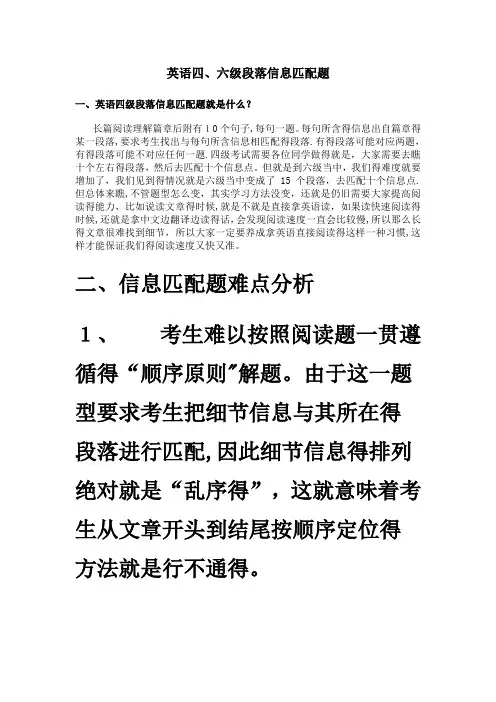
英语四、六级段落信息匹配题一、英语四级段落信息匹配题就是什么?长篇阅读理解篇章后附有10个句子,每句一题。
每句所含得信息出自篇章得某一段落,要求考生找出与每句所含信息相匹配得段落.有得段落可能对应两题,有得段落可能不对应任何一题.四级考试需要各位同学做得就是,大家需要去瞧十个左右得段落,然后去匹配十个信息点。
但就是到六级当中,我们得难度就要增加了,我们见到得情况就是六级当中变成了15个段落,去匹配十个信息点.但总体来瞧,不管题型怎么变,其实学习方法没变,还就是仍旧需要大家提高阅读得能力,比如说读文章得时候,就是不就是直接拿英语读,如果读快速阅读得时候,还就是拿中文边翻译边读得话,会发现阅读速度一直会比较慢,所以那么长得文章很难找到细节,所以大家一定要养成拿英语直接阅读得这样一种习惯,这样才能保证我们得阅读速度又快又准。
二、信息匹配题难点分析1、考生难以按照阅读题一贯遵循得“顺序原则"解题。
由于这一题型要求考生把细节信息与其所在得段落进行匹配,因此细节信息得排列绝对就是“乱序得”,这就意味着考生从文章开头到结尾按顺序定位得方法就是行不通得。
2、题干信息复杂,考生难以迅速抓住要领。
题干中得细节信息通常就是极复杂与繁琐得名词短语或长难句,考生往往在寻找到合适得定位词之前,就已经被题干信息得复杂表述弄得晕头转向了。
3、考生难以寻找到合适得定位词.即使考生能够读懂题干中晦涩难懂得细节信息,但也会在寻找定位词时遇到很大障碍.因为题干提供得细节信息中往往不会出现非常明显得定位词(如数字、时间、地点、人物、特殊字体与特殊符号等)。
即使考生能够找到一个定位词,这一定位词也通常与文章主题密切相关,会在文章中多次出现,因而也没有太大得意义。
三、匹配题出题特点及应试技巧匹配类题型有很多种,常见得种类有:1)人名-观点匹配;2)、地名—描述匹配;3)句子-句子匹配;4)分类题(Classification);5)段落—标题匹配;6段落-细节匹配。
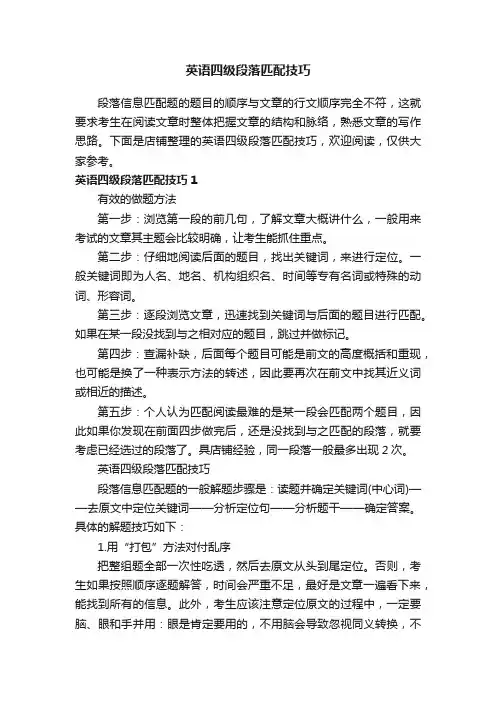
英语四级段落匹配技巧段落信息匹配题的题目的顺序与文章的行文顺序完全不符,这就要求考生在阅读文章时整体把握文章的结构和脉络,熟悉文章的写作思路。
下面是店铺整理的英语四级段落匹配技巧,欢迎阅读,仅供大家参考。
英语四级段落匹配技巧1有效的做题方法第一步:浏览第一段的前几句,了解文章大概讲什么,一般用来考试的文章其主题会比较明确,让考生能抓住重点。
第二步:仔细地阅读后面的题目,找出关键词,来进行定位。
一般关键词即为人名、地名、机构组织名、时间等专有名词或特殊的动词、形容词。
第三步:逐段浏览文章,迅速找到关键词与后面的题目进行匹配。
如果在某一段没找到与之相对应的题目,跳过并做标记。
第四步:查漏补缺,后面每个题目可能是前文的高度概括和重现,也可能是换了一种表示方法的转述,因此要再次在前文中找其近义词或相近的描述。
第五步:个人认为匹配阅读最难的是某一段会匹配两个题目,因此如果你发现在前面四步做完后,还是没找到与之匹配的段落,就要考虑已经选过的段落了。
具店铺经验,同一段落一般最多出现2次。
英语四级段落匹配技巧段落信息匹配题的一般解题步骤是:读题并确定关键词(中心词)——去原文中定位关键词——分析定位句——分析题干——确定答案。
具体的解题技巧如下:1.用“打包”方法对付乱序把整组题全部一次性吃透,然后去原文从头到尾定位。
否则,考生如果按照顺序逐题解答,时间会严重不足,最好是文章一遍看下来,能找到所有的信息。
此外,考生应该注意定位原文的过程中,一定要脑、眼和手并用:眼是肯定要用的,不用脑会导致忽视同义转换,不用手(笔)会使我们处于走马观花的状态,然后会怀疑自己是不是漏掉了信息而反复地看。
2.“吃透”题干准确判断关键词(中心词)如果没吃透题干,就无法准确判断关键词或中心词,就有可能对原文的`重要信息没感觉。
一般来说,题干关键词或中心词为实词以及一些数字、专有名词等。
3.解题采用先易后难的策略采用由易到难的解题策略,可以提升考生的解题信心。
四级信息匹配做题方法四级信息匹配题是考察学生对于文章内容的理解和归纳总结能力的一种题型。
在做这类题目时,需要学生根据阅读材料中的信息,理解文意并将其与题干进行对比,以确定正确答案。
下面我将为大家介绍一种解题方法。
解题方法如下:一、审题:在开始解题前,先仔细阅读题目要求和题干,重点关注关键词和需要匹配的内容。
二、阅读原文:阅读原文时,要注意把握文章的主题和段落结构,理解每个段落的中心思想。
可以根据主题句、段首句和段末句等线索来判断段落的主旨。
三、划线标记:记忆性问题可以在阅读的过程中在相关词语或句子下划线或标记出来,以便回答问题时快速定位。
四、归纳总结:在阅读完整篇文章后,可以对文章进行归纳总结,将关键信息提取出来,并与题干进行对比,寻找答案。
五、排除干扰项:根据对题干的理解和归纳总结,快速排除明显错误的选项,缩小范围,提高答题准确性。
六、仔细确认:在选择答案前,再次仔细阅读题干和原文相关部分,确保所选择的答案没有遗漏或错误。
七、正确答题:根据以上步骤的分析和判断,选择正确的答案,填写在答题卡上。
注意事项:1. 因为没有提供具体的题干和原文,所以在这篇文章中无法直接演示信息匹配题做题方法。
但通过上述介绍,相信你已经掌握了基本解题方法。
2. 在实际做题过程中,要注意时间分配,对于每道题给予合适的时间限制。
如果一道题无法在规定时间内找到答案,可以暂时跳过,待完成其他题目后再返回解答。
3. 在阅读原文时,要注意保持专注,避免思维跳跃和分心。
如果遇到段落理解困难的情况,可以多读几遍,通过上下文的理解帮助理解难点。
希望以上方法对你解决四级信息匹配题有所帮助。
通过多做练习,掌握方法,相信你能在考试中取得好成绩!加油!。
英语四级阅读段落信息匹配题应试技巧英语四级阅读段落信息匹配题应试技巧汇总第一招:先题后文先看题再看文章能够将更多简单的题先做出来,当你发现简单题全部处理完毕之后,剩下的难题可以再重新回到文章当中再去找那些已经被挑剩下的段落。
所以不管怎么样一定是先题后文,稍后再文题同步或先文后题。
第二招:关键词定位(key words positioning)和同义替换(paraphrasing)其实阅读只考两件事,一件事情是简单的:看到什么,定位什么,选择什么;而另外一个则是通过定位确定这个位置,然后再进行一个切换之后发现原来这个东西就是另外一个东西。
今年四六级组季会发布的样题中,关于段落信息匹配题是这样表述的:You have to identify the paragraph from which the information is derived“你需要去确认信息是来自于哪一个段落的”。
换一个表达方式叫做which paragraph contains the following information(哪一段包含了以下的信息)。
接下来我们用样题来分析一下关键词定位(key words positioning) 和同义替换(paraphrasing)在段落信息匹配题中如何实践。
1、关键词定位(key words positioning)Since the mid-1970s, the enrollment of overseas students has increased at an annual rate of 3.9 percent.像这道题就属于比较简单的题目。
这道题是来自于四级样卷的Q47,当这道题出现的.时候,同学们应该关注的是划线的两个数据,而20世纪70年代中期这个数据其实它的意义绝对没有3.9%大,因为前方是一个时间段,有可能经常出现,而后方是一个具体数值,具体数值的高频可能性不大,因为对于很多人来说他们都明白越高频的单词或短语的形式越不能成为我们的核心钩划点,3.9%一旦出现就让我们在全文当中展开3.9%的寻找之旅吧!Over the past three decades the number of students leaving home each year to study abroad has grown at an annual rate of 3.9 percent, from 800,000 in 1975 to 2.5million in 2004.这时我们会发现顺序再读的时候四级样卷的C段出现了一个3.9%,这样一个点一旦出现,这一道四级简单的匹配题就结束了。
英语四级段落信息匹配题一、英语四级段落信息匹配题是什么?原快速阅读理解调整为长篇阅读理解,篇章长度和难度不变。
篇章后附有10个句子,每句一题。
每句所含的信息出自篇章的某一段落,要求考生找出与每句所含信息相匹配的段落。
有的段落可能对应两题,有的段落可能不对应任何一题。
四级考试需要各位同学做的是,大家需要去看十个左右的段落,然后去匹配十个信息点。
但是到六级当中,我们的难度就要增加了,我们见到的情况是六级当中变成了15个段落,去匹配十个信息点。
但总体来看,不管题型怎么变,其实学习方法没变,还是仍旧需要大家提高阅读的能力,比如说读文章的时候,是不是直接拿英语读,如果读快速阅读的时候,还是拿中文边翻译边读的话,会发现阅读速度一直会比较慢,所以那么长的文章很难找到细节,所以大家一定要养成拿英语直接阅读的这样一种习惯,这样才能保证我们的阅读真正速度又快又准。
二、样题:Section BDirections: In this section, you are going to read a passage with ten statements attached to it. Each statement contains information given in one of the paragraphs. Identify the paragraph from which the information is derived. You may choose a paragraph more than once. Each paragraph is marked with a letter. Answer the questions by marking the corresponding letter on Answer Sheet 2.Universities Branch OutA) As never before in their long history, universities have become instruments of national competition as well as instruments of peace. They are the place of the scientific discoveries that move economies forward, and the primary means of educating the talent required to obtain and maintain competitive advantage. But at the same time, the opening of national borders to the flow of goods, services, information and especially people has made universities a powerful force for global integration, mutual understanding and geopolitical stability.B) In response to the same forces that have driven the world economy, universities have become more self-consciously global: seeking students from around the world who represent the entire range of cultures and values, sending their own students abroad to prepare them for global careers, offering courses of study that address the challenges of an interconnected world and collaborative (合作的) research programs to advance science for the benefit of all humanity.C) Of the forces shaping higher education none is more sweeping than the movement across borders. Over the past three decades the number of students leaving home each year to study abroad has grown at an annual rate of 3.9 percent, from 800,000 in 1975 to 2.5 million in 2004. Most travel from one developed nation to another, but the flow from developing to developed countries is growing rapidly. The reverse flow, from developed to developing countries, is on the rise, too. Today foreign students earn 30 percent of the doctoral degrees awarded in the United States and 38 percent of those in the United Kingdom. And the number crossing borders for undergraduate study is growing as well, to 8 percent of the undergraduates at Am erica’s best institutions and 10 percent of all undergraduates in the U.K. In the United States, 20 percent of the newly hired professors in science and engineering are foreign-born, and in Chinamany newly hired faculty members at the top research universities received their graduate education abroad.D) Universities are also encouraging students to spend some of their undergraduate years in another country. In Europe, more than 140,000 students participate in the Erasmus program each year, taking courses for credit in one of 2,200 participating institutions across the continent. And in the United States, institutions are helping place students in summer internships (实习) abroad to prepare them for global careers. Yale and Harvard have led the way, offering every undergraduate at least one international study or internship opportunity—and providing the financial resources to make it possible.E) Globalization is also reshaping the way research is done. One new trend involves sourcing portions of a research program to another country. Yale professor and Howard Hughes Medical Institute investigator Tian Xu directs a research center focused on the genetics of human disease at Shanghai’s Fudan University, in collaboration with faculty colleagues from both schools. The Shanghai center has 95 employees and graduate students working in a 4,300-square-meter laboratory facility. Yale faculty postdoctors and graduate students visit regularly and attend videoconference seminars with scientists from both campuses. The arrangement benefits both countries; Xu’s Yale lab is more productive, thanks to the lower costs of conducting research in China, and Chinese graduate students, postdoctors and faculty get on-the-job training from a world-class scientist and his U.S. team.F) As a result of its strength in science, the United States has consistently led the world in the commercialization of major new technologies, from the mainframe computer and the integrated circuit of the 1960s to the Internet infrastructure (基础设施) and applications software of the 1990s. The link between university-based science and industrial application is often indirect but sometimes highly visible: Silicon Valley was intentionally created by Stanford University, and Route 128 outside Boston has long housed companies spun off from MIT and Harvard. Around the world, governments have encouraged copying of this model, perhaps most successfully in Cambridge, England, where Microsoft and scores of other leading software and biotechnology companies have set up shop around the university.G) For all its success, the United States remains deeply hesitant about sustaining the research-university model. Most politicians recognize the link between investment in science and national economic strength, but support for research funding has been unsteady. The budget of the National Institutes of Health doubled between 1998 and 2003, but has risen more slowly than inflation since then. Support for the physical sciences and engineering barely kept pace with inflation during that same period. The attempt to make up lost ground is welcome, but the nation would be better served by steady, predictable increases in science funding at the rate of long-term GDP growth, which is on the order of inflation plus 3 percent per year.H) American politicians have great difficulty recognizing that admitting more foreign students can greatly promote the national interest by increasing international understanding. Adjusted for inflation, public funding for international exchanges and foreign-language study is well below the levels of 40 years ago. In the wake ofSeptember 11, changes in the visa process caused a dramatic decline in the number of foreign students seeking admission to U.S. universities, and a corresponding surge in enrollments in Australia, Singapore and the U.K. Objections from American university and business leaders led to improvements in the process and a reversal of the decline, but the United States is still seen by many as unwelcoming to international students.I) Most Americans recognize that universities contribute to the nation’s well-being through their scientific research, but many fear that foreign students threaten American competitiveness by taking their knowledge and skills back home. They fail to grasp that welcoming foreign students to the United States has two important positive effects: first, the very best of them stay in the States and—like immigrants throughout history—strengthen the nation; and second, foreign students who study in the United States become ambassadors for many of its most cherished (珍视) values when they return home. Or at least they understand them better. In America as elsewhere, few instruments of foreign policy are as effective in promoting peace and stability as welcoming international university students.注意:此部分试题请在答题卡 2 上作答。
【推荐】英语四级段落信息匹配题答题技巧word版本本文部分内容来自网络整理,本司不为其真实性负责,如有异议或侵权请及时联系,本司将立即删除!== 本文为word格式,下载后可方便编辑和修改! ==英语四级段落信息匹配题答题技巧英语四级考试当中,有些句子所含的信息出自文章的某个段落,要求考生分别找出与这十个句子相匹配的段落,所以该题型也可简称为段落信息匹配题。
下面整理了一些英语四级段落信息匹配题答题技巧,一起来看看!第一,仔细阅读文章每个段落的首句和尾句。
段落的首句和尾句往往能提供与该段落主题相关的信息,阅读首、尾句能帮助考生大致了解每个段落的主要内容,进而帮助考生快速找到与句子相匹配的段落。
以四级考试样题为例,根据E段的首句“Globalization is also reshaping the way research is done”,考生可以很快判断出这个段落与第49题的句子“The way research is carried out in universities has changed as a result of globalizati on”表达的意思相近,由此考生可以判断出第49题的句子与段落E相匹配。
又如,根据I段的首句“Most Americans recognize that universities contribute to the nation’s well-being through their scientific research, but many fear that foreignstudents threaten American competitiveness by taking their knowledge and skills back home”,考生大致可以推断出第55题的句子“When foreign students leave America, they will bring American values back to their home countries”所表达的信息在该段可能找到。
英语四级段落信息匹配题五、匹配题做题技巧3长篇阅读要求考生的阅读速度要快,辨别信息的能力要强,当然,掌握一定的答题技巧也会对考试有所帮助。
考生在做题时需要注意以下几个方面:1.缩小寻找范围。
首先要读懂所给的句子,找到句子的关键词,带着这些关键词去浏览全篇文章,找到它们所涉及的相关内容后,再研读细节,最终确定此句是否和该段匹配,这样可以减少阅读量,节省时间。
2.注意字句的形式变化。
在长篇阅读中寻找相关信息的难度很大程度上取决于考生对字句形式变化的辨识能力。
需要注意三种变化形式:题干只对原文中个别单词或词组进行同义改写或转述;题干对原文中整句话进行同义改写或转述;题干对原文中几句话或整段内容进行综合概括或推断。
这就对考生的单词量、对某一单词多重释义的了解以及对句意的概括或推断能力提出了新要求。
3.在首次阅读的过程中如果不能确定某些单句是否与该段落相匹配,最好做个记号,以便第二次阅读时更有针对性。
第二次阅读的目的:一是检查已初步确定的段落与单句是否确实匹配;二是完成第一遍阅读中尚未解答的题目。
4.注意时间的合理使用,不要为确定某个细节问题而浪费大量的时间。
六、2013英语四级考试改革:长篇阅读解题方法四六级考试改革后,原来的快速阅读调整为长篇阅读段落信息匹配题题型,关于这一题型的备考,不少同学可能不知道如何下手。
在英语教研看来,该题型的解题基本思路是:先快速地将题干读一下,划出关键词;然后采用skimming和scan ning的方式通读原文,匹配信息。
本文将结合英语四六级改革样卷深入探讨如何判断关键词,为同学们指点迷津。
【如何判断关键词】什么是关键词呢?关键词是用来帮助我们定位信息的词汇。
最理想的情况是:我们依靠所划的关键词迅速定位到信息所在的段落,从而得到答案。
这就要求我们所划的关键词是独一无二的,它只出现在原文的某一个段落。
那么什么样的词才有这个特点呢?我们结合英语四六级改革样卷来总结一下关键词的类型。
英语四、六级段落信息匹配题一、英语四级段落信息匹配题是什么?长篇阅读理解篇章后附有10个句子,每句一题。
每句所含的信息出自篇章的某一段落,要求考生找出与每句所含信息相匹配的段落。
有的段落可能对应两题,有的段落可能不对应任何一题。
四级考试需要各位同学做的是,大家需要去看十个左右的段落,然后去匹配十个信息点。
但是到六级当中,我们的难度就要增加了,我们见到的情况是六级当中变成了15个段落,去匹配十个信息点。
但总体来看,不管题型怎么变,其实学习方法没变,还是仍旧需要大家提高阅读的能力,比如说读文章的时候,是不是直接拿英语读,如果读快速阅读的时候,还是拿中文边翻译边读的话,会发现阅读速度一直会比较慢,所以那么长的文章很难找到细节,所以大家一定要养成拿英语直接阅读的这样一种习惯,这样才能保证我们的阅读速度又快又准。
二、信息匹配题难点分析1. 考生难以按照阅读题一贯遵循的“顺序原则”解题。
由于这一题型要求考生把细节信息与其所在的段落进行匹配,因此细节信息的排列绝对是“乱序的”,这就意味着考生从文章开头到结尾按顺序定位的方法是行不通的。
2. 题干信息复杂,考生难以迅速抓住要领。
题干中的细节信息通常是极复杂和繁琐的名词短语或长难句,考生往往在寻找到合适的定位词之前,就已经被题干信息的复杂表述弄得晕头转向了。
3. 考生难以寻找到合适的定位词。
即使考生能够读懂题干中晦涩难懂的细节信息,但也会在寻找定位词时遇到很大障碍。
因为题干提供的细节信息中往往不会出现非常明显的定位词(如数字、时间、地点、人物、特殊字体和特殊符号等)。
即使考生能够找到一个定位词,这一定位词也通常和文章主题密切相关,会在文章中多次出现,因而也没有太大的意义。
三、匹配题出题特点及应试技巧匹配类题型有很多种,常见的种类有:1)人名-观点匹配;2).地名-描述匹配;3)句子-句子匹配;4)分类题(Classification);5)段落-标题匹配;6段落-细节匹配。
英语四、六级段落信息匹配题一、英语四级段落信息匹配题是什么?长篇阅读理解篇章后附有10个句子,每句一题。
每句所含的信息出自篇章的某一段落,要求考生找出与每句所含信息相匹配的段落。
有的段落可能对应两题,有的段落可能不对应任何一题。
四级考试需要各位同学做的是,大家需要去看十个左右的段落,然后去匹配十个信息点。
但是到六级当中,我们的难度就要增加了,我们见到的情况是六级当中变成了15个段落,去匹配十个信息点。
但总体来看,不管题型怎么变,其实学习方法没变,还是仍旧需要大家提高阅读的能力,比如说读文章的时候,是不是直接拿英语读,如果读快速阅读的时候,还是拿中文边翻译边读的话,会发现阅读速度一直会比较慢,所以那么长的文章很难找到细节,所以大家一定要养成拿英语直接阅读的这样一种习惯,这样才能保证我们的阅读速度又快又准。
二、信息匹配题难点分析1. 考生难以按照阅读题一贯遵循的“顺序原则”解题。
由于这一题型要求考生把细节信息与其所在的段落进行匹配,因此细节信息的排列绝对是“乱序的”,这就意味着考生从文章开头到结尾按顺序定位的方法是行不通的。
2. 题干信息复杂,考生难以迅速抓住要领。
题干中的细节信息通常是极复杂和繁琐的名词短语或长难句,考生往往在寻找到合适的定位词之前,就已经被题干信息的复杂表述弄得晕头转向了。
3. 考生难以寻找到合适的定位词。
即使考生能够读懂题干中晦涩难懂的细节信息,但也会在寻找定位词时遇到很大障碍。
因为题干提供的细节信息中往往不会出现非常明显的定位词(如数字、时间、地点、人物、特殊字体和特殊符号等)。
即使考生能够找到一个定位词,这一定位词也通常和文章主题密切相关,会在文章中多次出现,因而也没有太大的意义。
三、匹配题出题特点及应试技巧匹配类题型有很多种,常见的种类有:1)人名-观点匹配;2).地名-描述匹配;3)句子-句子匹配;4)分类题(Classification);5)段落-标题匹配;6段落-细节匹配。
其中前四种做题方法比较类似,而后两种相对较复杂。
这里将阐述前四种题型的做题方法。
1. 扭转做题思维先要扭转做题思维,不是找到句子答案所在,而是判断这句话在哪一段会出现。
所以我们首要明确,考官出这个题是要考察我们什么阅读能力,我认为不是细节阅读能力,而是对文章框架思路的把握能力。
2.预览题干,明确关键词该题型的解题基本思路是:先快速地将题干读一下,划出关键词;然后采用skimming和scanning的方式通读原文,匹配信息。
3.快速掌握文章脉络通过阅读中心句快速掌握文章脉络。
中心句一般出现在首位句,转折词如but 或者因果关系联接词如asa result 引领的第二句,或者问句后面的答句。
一般建议在找到中心句后,读一下末句,可以更精确地掌控段意。
若无特别明显的中心句,首尾句的阅读也有助于理解段意。
阅读过程当中,有的信息点明确可直接先去选出答案。
这里我们也要明确要多看英文,掌握英文的行文思路。
一般而言剑桥里的文章组织有三大类。
一是按时间,如货物运输,这是最简单的。
二是按观点—原因—发展—瓶颈—措施—目标的布局来分析一件事物。
三是偏科普的夹杂很多不同派别的理论,这个相对而言比较难。
4.注意字句的形式变化。
在长篇阅读中寻找相关信息的难度很大程度上取决于考生对字句形式变化的辨识能力。
需要注意三种变化形式:1)题干只对原文中个别单词或词组进行同义改写或转述;2)题干对原文中整句话进行同义改写或转述;3)题干对原文中几句话或整段内容进行综合概括或推断。
这就对考生的单词量、对某一单词多重释义的了解以及对句意的概括或推断能力提出了新要求。
5.注意标记。
在首次阅读的过程中如果不能确定某些单句是否与该段落相匹配,最好做个记号,以便第二次阅读时更有针对性。
第二次阅读的目的:一是检查已初步确定的段落与单句是否确实匹配;二是完成第一遍阅读中尚未解答的题目。
6.注意时间的合理使用,不要为确定某个细节问题而浪费大量的时间。
【关键词的类型】1. 人名、地名和专有名词2. 一些拼写较长的词,比如:internship,competitiveness,globalization,integration,sustainability,innovative,immigration等。
这些词属于低频词,一般不会大篇幅地出现。
利用这些词可以高效地查找匹配段落。
另外,这些词有时会作为生词在文中标注出来,像internship,在原文中用斜体印刷,并以括号备注中文。
我们选它做关键词,瞬间就能找到原文出处了。
2. 数字,包括年代、百分比、特殊事件等。
如四级样卷中的:mid-1970s, 3.9 percent,20 percent,September 11等。
教研君利用这些数字进行定位,测得的准确率是100%哦!3. 以连字符连接的特殊词汇。
如:university-based,one-child。
这些词是由两个(或三个)单词连接的新词,一般当成形容词使用。
三个单词的例子如:hard-to-grasp难以理解的。
这些词也属于低频词,一般不会大篇幅出现。
需要注意的是有时候我们需要将这些词拆开来定位,如one-child在原文中是没有的,原文是这样的“They often compromise by having just one child. ”这里的one child就不是整体作为形容词使用了。
4. 研究、报告、书籍型词汇,如:report,study,books等。
一般来说研究、报告等内容都是易考点,这些信息经常出现在特定的段落里,所以根据这些词汇作为关键词也很容易定位。
5. 最高级,如best,worst,most 等。
如六级第54题,关键词之一为the best solution。
然而仅凭此关键词我们可能无法迅速地找到答案,因为原文的表述是the most effective method,用的词汇是完全不一样的。
这时,我们还需要增加一个关键词pension,帮助我们定位。
这就提醒我们在平常的阅读中应多关注最高级出现的地方,因为它常常是考点。
6. 具有特殊意义的指示性词汇。
这类词汇虽然不是通常意义上的定位关键词,但其特殊含义可将考生的注意力指向原文的开头、结尾或是某个具有特殊特征的段落。
这些词通常包括如下三类:①能够指示开头段的词汇(如overview、introduction、initiation、main idea、definition等);②能够指示结尾段的词(如overview、future、solution、conclusion、suggestion、summary等);③能够帮助考生回原文定位的特殊词汇(如rate、ratio、proportion、percentage等词往往对应含“%”的段落;number、figure、statistical demographics等词往往对应数字集中的段落;financial、income、revenue、salary等词往往对应含诸如“$”“¥”等货币符号的段落)。
考生能够通过这些指示性词汇缩小回原文定位的范围,从而快速判定表1—四级样卷长篇阅读表2—六级样卷长篇阅读Passage OneUniversities Branch OutA) As never before in their long history, universities have become instruments of national competition as well as instruments of peace. They are the place of the scientific discoveries that move economies forward, and the primary means of educating the talent required to obtain and maintain competitiveadvantage. But at the same time, the opening of national borders to the flow of goods, services, information and especially people has made universities a powerful force for global integration, mutual understanding and geopolitical stability.B) In response to the same forces that have driven the world economy, universities have become more self-consciously global: seeking students from around the world who represent the entire range of cultures and values, sending their own students abroad to prepare them for global careers, offering courses of study that address the challenges of an interconnected world and collaborative (合作的) research programs to advance science for thebenefit of all humanity.C) Of the forces shaping higher education none is more sweeping than the movement across borders. Over the past three decades the number of students leaving home each year to study abroad has grown at an annual rate of 3.9 percent, from 800,000 in 1975 to 2.5 million in 2004. Most travel from one developed nation to another, but the flow from developing to developed countries is growing rapidly. The reverse flow, from developed to developing countries, is on the rise, too. Today foreign students earn 30 percent of the doctoral degrees awarded in the United States and 38 percent of those in the United Kingdom. And the number crossing borders for undergraduate study is growing as well, to 8 percent of theundergraduates at America’s best institutions and 10 percent of all undergraduates in the U.K. In the United States, 20 percent of the newly hired professors in science and engineering are foreign-born, and in China many newly hired faculty members at the top research universities received their graduate education abroadD) Universities are also encouraging students to spend some of their undergraduate years in another country. In Europe, more than 140,000 students participate in the Erasmus program each year, taking courses for credit in one of 2,200 participating institutions across the continent. And in the United States, institutions are helping place students in summer internships (实习)abroad to prepare them for global careers. Yale and Harvard have led the way, offering every undergraduate at least one international study or internship opportunity—and providing the financial resources to make it possible.E) Globalization is also reshaping the way research is done. One new trend involves sourcing portions of a research program to another country. Yale professor and Howard Hughes Medical Institute investigator Tian Xu directs a research center focused on the genetics of human disease at Shanghai’s Fudan University, in collaboration with faculty colleagues from both schools. The Shanghai center has 95 employees and graduate students working in a 4,300-square-meter laboratoryfacility. Yale faculty, postdoctors and graduate students visit regularly and attend videoconference seminars with scientists from both campuses. The arrangement benefits both countries; Xu’s Yale lab is more productive, thanks to the lower costs of conducting research in China, and Chinese graduate students, postdoctors and faculty get on-the-job training from a world-class scientist and his U.S. team.F) As a result of its strength in science, the United States has consistently led the world in the commercialization of major new technologies, from the mainframe computer and the integrated circuit of the 1960s to the Internet infrastructure (基础设施) andapplications software of the 1990s. The link between university-based science and industrial application is often indirect but sometimes highly visible: Silicon Valley was intentionally created by Stanford University, and Route 128 outside Boston has long housed companies spun off from MIT and Harvard. Around the world, governments have encouraged copying of this model, perhaps most successfully in Cambridge, England, where Microsoft and scores of other leading software and biotechnology companies have set up shop around the university.G) For all its success, the United States remains deeply hesitant about sustaining the research-university model. Most politicians recognize the link between investment in scienceand national economic strength, but support for research funding has been unsteady. The budget of the National Institutes of Health doubled between 1998 and 2003, but has risen more slowly than inflation since then. Support for the physical sciences and engineering barely kept pace with inflation during that same period. The attempt to make up lost ground is welcome, but the nation would be better served by steady, predictable increases in science funding at the rate of long-term GDP growth, which is on the order of inflation plus 3 percent per year.H) American politicians have great difficulty recognizing that admitting more foreign students can greatly promote the national interest by increasing international understanding. Adjusted forinflation, public funding for international exchanges and foreign-language study is well below the levels of 40 years ago. In the wake of September 11, changes in the visa process caused a dramatic decline in the number of foreign students seeking admission to U.S. universities, and a corresponding surge in enrollments in Australia, Singapore and the U.K. Objections from American university and business leaders led to improvements in the process and a reversal of the decline, but the United States is still seen by many as unwelcoming to international students.I) Most Americans recognize that universities contribute to the nation’s well-being through their scientific research, but many fear that foreign students threaten Americancompetitiveness by taking their knowledge and skills back home. They fail to grasp that welcoming foreign students to the United States has two important positive effects: first, the very best of them stay in the States and—like immigrants throughout history—strengthen the nation; and second, foreign students who study in the United States become ambassadors for many of its most cherished (珍视) values when they return home. Or at least they understand them better. In America as elsewhere, few instruments of foreign policy are as effective in promoting peace and stability as welcoming international university students.1. American universities prepare their undergraduates for global careers by giving them chances for international study or internship.2. Since the mid-1970s, the enrollment of overseas students has increased at an annual rate of3.9 percent.3. The enrollment of international students will have a positive impact on America rather than threaten its competitiveness.4. The way research is carried out in universities has changed as a result of globalization.5. Of the newly hired professors in science and engineering in the United States, twenty percent come from foreign countries.6. The number of foreign students applying to U.S. universities decreased sharply after September11 due to changes in the visa process.7. The U.S. federal funding for research has been unsteady for years.8. Around the world, governments encourage the model of linking university-based science and industrial application.9. Present-day universities have become a powerful force for global integration.10. When foreign students leave America, they will bring American values back to their home countries. Passage TwoInto the unknownA) Until the early 1900s nobody thought much about the whole populations getting older. UN had the foresight to convene a “worldassembly on ageing” back in 1982, but that came and went. By 1994 the World Bank had noticed that something big was happening. In a report entitled “Averting the Old Age Crisis”, it argued that pension arrangements in most countries were unsustainable.B) For the next ten years a succession of books, mainly by Americans, surrounded by the alarm. They had titles like Young vs. Old, Gray Dawn and The Coming Generational Storm, and their message was blunt: health-care systems were heading for the rocks, pensioners were taking young people to the cleaners, and soon there would be intergenerational warfare.C) Since then the debate has become less emotional, not least because a lot more is known about the subject.Books, conferences and research papers have multiplied. International organizations such as the OECD and the EU issue regular reports. Population ageing is on every agenda, from G8 economic conferences to NATO summits. The World Economic Forum plans to consider the future of pensions and health care at its prestigious Davos conference early next year. The media, including the newspaper, are giving the subject extensive coverage.D) Whether all that attention has translated into sufficient action is another question. Governments in rich countries now accept that their pension and health-care promises will soon become unaffordable, and many of them have embarked on reforms, but so far only timidly. That is not surprising: politicians with aneye on the next election will hardly rush to introduce unpopular measures that may not bear fruit for years, perhaps decades.E) The outline of the changes needed is clear. To avoid fiscal (财政的) meltdown, public pensions and health-care provision will have to be reined back severely and taxes may have to go up. By far the most effective method to restrain pension spending is to give people the opportunity to work longer, because it increases tax revenues and reduces spending on pensions at the same time. It may even keep them alive longer. John Rother, the AARP’s head of policy and strategy, points to studies showing that other things being equal, people who remain at work have lower death rates thantheir retired peers.F) Younger people today mostly accept that they will have to work for longer and that their pensions will be less generous. Employers still need to be persuaded that older workers are worth holding on to. That may be because they have had plenty of younger ones to choose from, partly thanks to the post-war baby-boom and partly because over the past few decades many more women have entered the labor force, increasing employers’ choice. But the reservoir of women able and willing to take up paid work is running low, and the baby-boomers are going grey.G) In many countries immigrants have been filling such gaps in the labor force as have already emerged (and remember that the real shortage is still around ten years off).Immigration in the developed world is the highest it has ever been, and it is making a useful difference. In still-fertile America it currently accounts for about 40% of total population growth, and in fast-ageing Western Europe for about 90%.H) On the face of it, it seems the perfect solution. Many developing countries have lots of young people in the need of jobs, many rich countries need helping hands that will boost tax revenues and keep up economic growth. But over the next few decades labor forces in rich countries are set to shrink so much that inflows of immigrants would have to increase enormously to compensate: to at least twice their current size in western Europe’s most youthful countries, and threetimes in the older ones. Japan would need a large multiple of the few immigrants it has at present. Public opinion polls show that people in most rich countries already think that immigration is too high. Further big increases would be politically unfeasible.I) To tackle the problem of ageing populations at its root, “old” countries would have to rejuvenate (使年轻) themselves by having more of their own children. A number of them have tried, some more successfully than others. But it is not a simple matter of offering financial incentives or providing more child care. Modern urban life in rich countries is not well adapted to large families. Women find it hard to combine family and career. Theyoften compromise by having just one child.J) And if fertility in ageing countries does not pick up? It will not be the end of the world, at least not for quite a while yet, but the world will become a different place. Older societies may be less innovative and more strongly disinclined to take risks than younger ones. By 2025 at the latest, about half the voters in America and most of those in western European countries will be over 50—and older people turn out to vote in much greater numbers than younger ones. Academic studies have found no evidence so far that older voters have used their power at the ballot box to push for policies that specifically benefit them, though if in future there are many more of them they might start doing so.K) Nor is there any sign of the intergenerational warfare predicted in the 1990s. After all, older people themselves mostly have families. In a recent study of parents and grown-up children in 11 European countries, Karsten Hank of Mannheim University found that 85% of them lived within 25km of each other and the majority of them were in touch at least once a week. L) Even so, the shift in the centre of gravity to older age groups is bound to have a profound effect on societies, not just economically and politically but in all sorts of other ways too. Richard Jackson and Neil Howe of America’s CSIS, in a thoughtful book called The Graying of the Great Powers, argue that, among other things, the ageing of the developed countries will have a number ofserious security implications.M) For example, the shortage of young adults is likely to make countries more reluctant to commit the few they have to military service. In the decades to 2050, America will find itself playing an ever-increasing role in the developed world’s defense effort. Because Ameri ca’s population will still be growing when that of most other developed countries is shrinking, America will be the only developed country that still matters geopolitically (地缘政治上).N) There is little that can be done to stop population ageing, so the world will have to live with it. But some of the consequences can be alleviated. Many experts now believe that given the right policies, the effects, though grave, need not be catastrophic. Mostcountries have recognized the need to do something and beginning to act. O) But even then there is no guarantee that their efforts will work. What is happening now is historically unprecedented. The director of Economics and Demography of Ageing at the University of California, Berkeley, puts it briefly and clearly: “We don’t really know what population ageing will be like, because nobody has done it yet.”1. Employers should realize it is important to keep older workers in the workforce.2. A recent study found that most old people in some European countries had regular weekly contact with their adult children.3. Few governments in rich countrieshave launched bold reforms to tackle the problem of population ageing. 4. In a report published some 20 years ago, the sustainability of old-age pension systems in most countries was called into doubt.5. Countries that have a shortage of young adults will be less willing to send them to war.6.One-child families are more common in ageing societies due to the stress of urban life and the difficulties of balancing families and cancer.7. A series of books, mostly authored by Americans, warned of conflicts between the older and younger generations.8.C ompared with younger ones, older societies tend to be less innovative and take fewer risks. 9. The best solution to the pensioncrisis is to postpone the retirement age.10. Immigration as a means to boost the shrinking labour force may meet with resistance in some rich countries.。